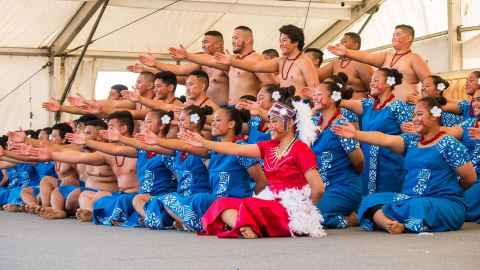Samoan language future beautiful to behold
31 May 2019
Opinion: Samoan Language Week reminds us how important knowledge of language and culture is to well-being, especially for young people, writes Mirofora Mataafa-Komiti.

On Monday the University of Auckland opened its official celebrations for le Vaiaso o le Gagana Samoa (Samoan Language Week). A focal point for the university’s Samoan and Pacific community, this year, was made even more memorable with the attendance of around 100 high school students from five different schools in Auckland, all of whom were taking Gagana Samoa (Samoa Language) as an NCEA subject.
As I looked upon the faces of those eager high school students, I couldn’t help but reflect on how far we have come in terms of the range of subjects being offered in high school. I remember when I was in high school, Te Reo, French, Spanish, German and Japanese were the only language options available even though in the entire school back then, I think we only had three Japanese students. Spanish, French and German students? Definitely scarce in the Auckland School that I attended (Papakura High School).
Samoan language as an NCEA subject was only a distant dream back then. Speaking Samoan was restricted to the Samoan Club lunchtime practice and in whispered conversations lest you be heard, earning stares which made you feel even smaller than you were already feeling.
I take my hat off to the Samoan educators who led the charge to include Gagana Samoa in the curriculum. Their work and the support of the Ministry of Education helped realise a new vision, and new opportunities for Samoan language.
Today, Gagana Samoa is taught from Aoga Amata (pre-school) right through to tertiary level. It is also the second most spoken language in Auckland, according to the 2013 Census data. Who would have thought? But the strength of Auckland’s second most spoken language sits next to a growing urgency around the need to preserve and encourage the ongoing growth of Gagana Samoa amongst our young people today. Older Samoans are more likely to speak Samoan than younger Samoans, and this is not a sustainable future. We must use, savour, celebrate and teach our Samoan language: this cannot be emphasised enough.
...the strength of Auckland’s second most spoken language sits next to a growing urgency around the need to preserve and encourage the ongoing growth of Gagana Samoa amongst our young people today.
Samoan is, for tens of thousands of New Zealanders, a language of family, faith, commerce and culture. The value of learning the Samoan language should never be under-estimated. For many Samoans living here, especially the second to third generation of Samoans who identify themselves as New Zealand-born Samoans, the common issues of struggling to maintain language and culture are very real. Many also struggle with loss of identity and loss of pride.
In a week where the nation is thinking about wellbeing, we should reflect on what research teaches us: that confidence and knowledge of your language and culture contributes to wellbeing and resilience, especially in young people. It also acts as a bridge across generations and across the ocean, to our Samoan homeland. As the learners immerse themselves into the language, they also immerse themselves into the cultural contexts behind the language. As their confidence in the language grows, so too does their confidence in themselves as Samoans. Consequently, it solidifies their identity and sense of pride.
The theme this year for Samoa Language week, ‘Lalaga le siosiomaga mo se lumanai manuia’ (Weave an environment for a better future) presents us with a challenge. When one weaves, one can use many different strands to make a desired pattern. While laying one strand down in a certain direction, the weaver will take another and place it in another direction. Another is added and another and another, all the while, the different strands are woven or connected and interlaced by the weaver so that each strand supports and strengthens the other. Though the strands are different, and though they may be placed in different directions, in the end, what has been woven is both logical and beautiful to behold.
We are all weavers and we have been given the task of weaving a better future. It is easy to keep to your own strand. But as learners, parents, teachers, elders and organisations from different backgrounds and different areas which teach and promote the Samoan language, our different strands need to connect and be allowed to be woven together to create an environment which will support our learners and strengthen the teaching and learning of the Samoan language in our communities.
Ultimately, the result will be confident learners who believe in themselves and who will in turn, be positive role-models and contributors to society in the future. Now won’t that be something beautiful to behold?
Aiolupotea Taitu'uga Mirofora Mataafa-Komiti is a professional teaching fellow in Pacific Studies, Faculty of Arts.
This article reflects the opinion of the author and not necessarily the views of the University of Auckland.
Used with permission from Newsroom A future of Samoan language beautiful to behold published on 31 May 2019.